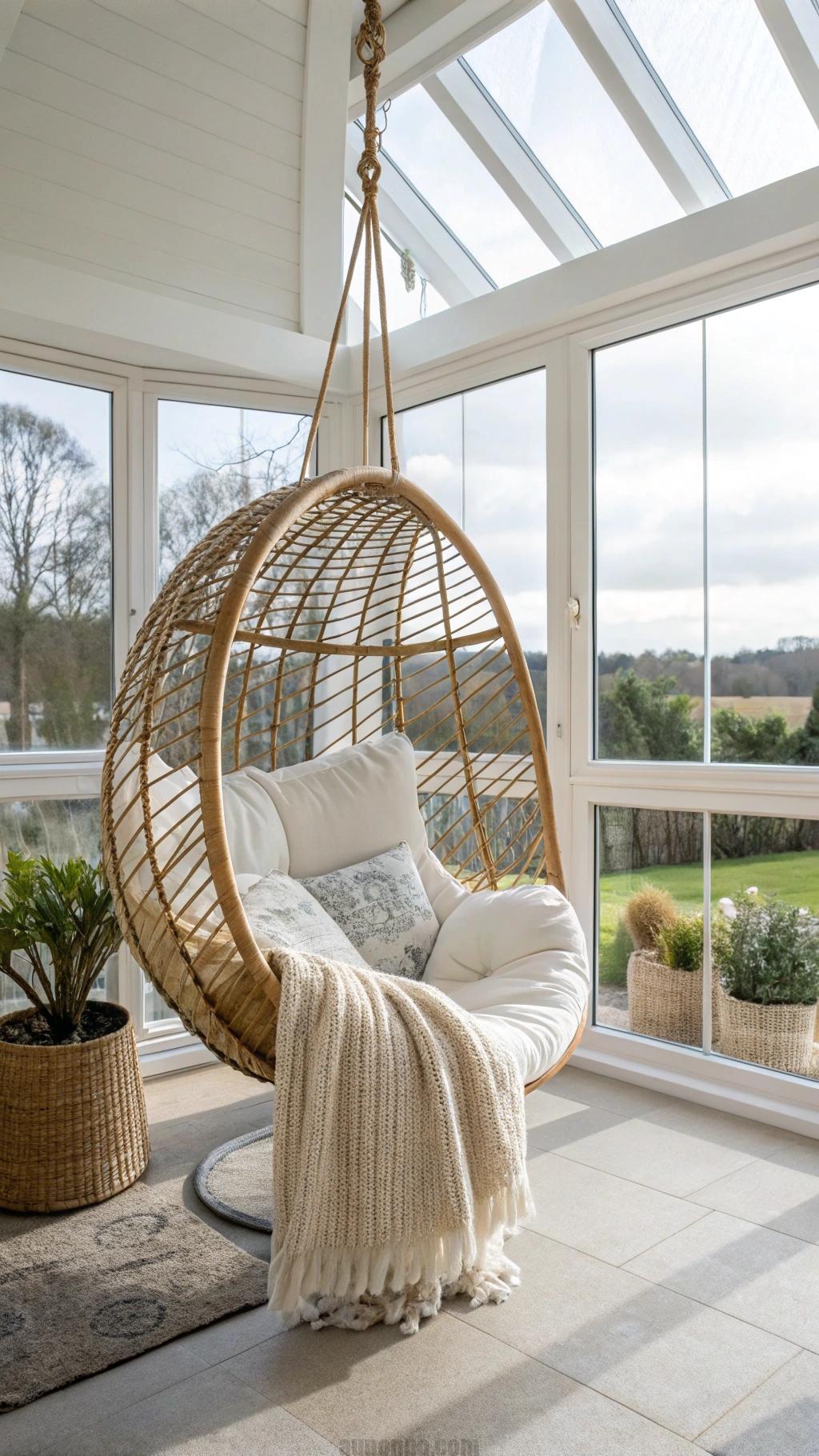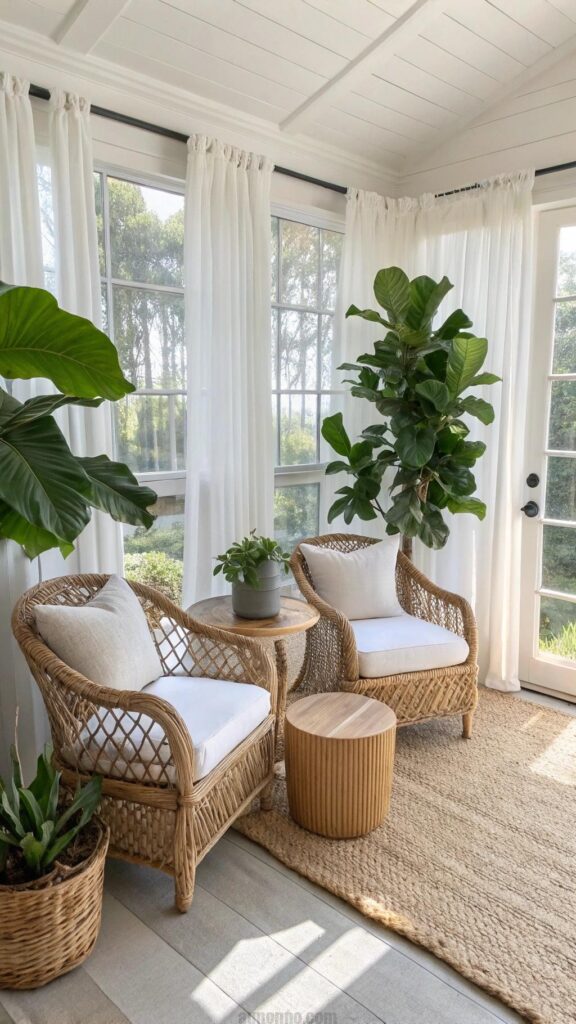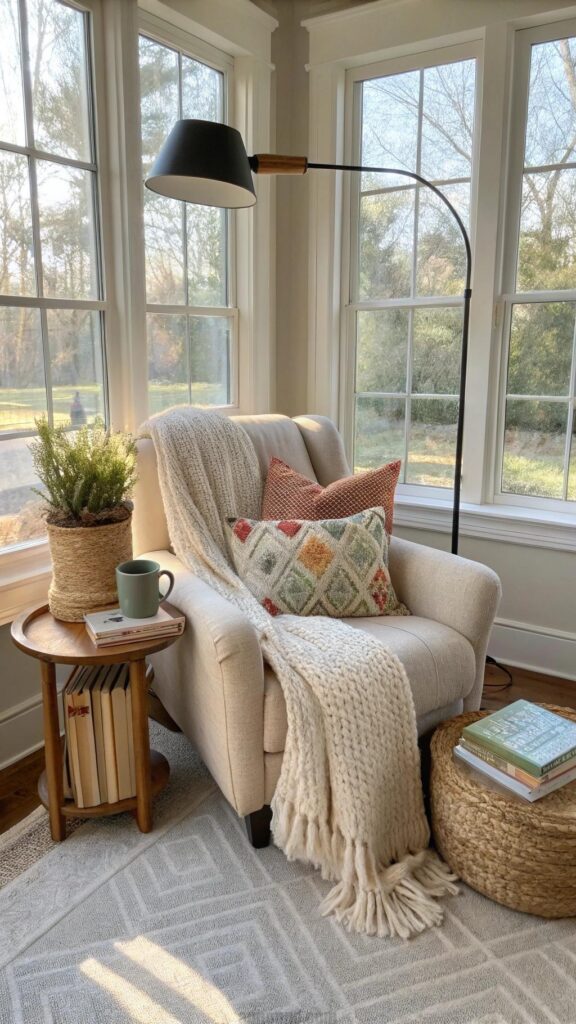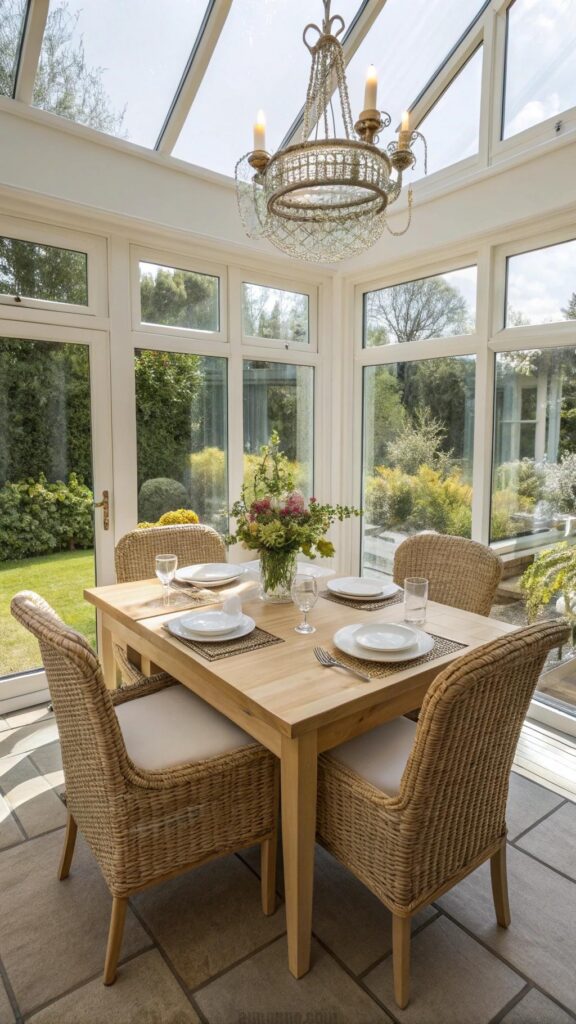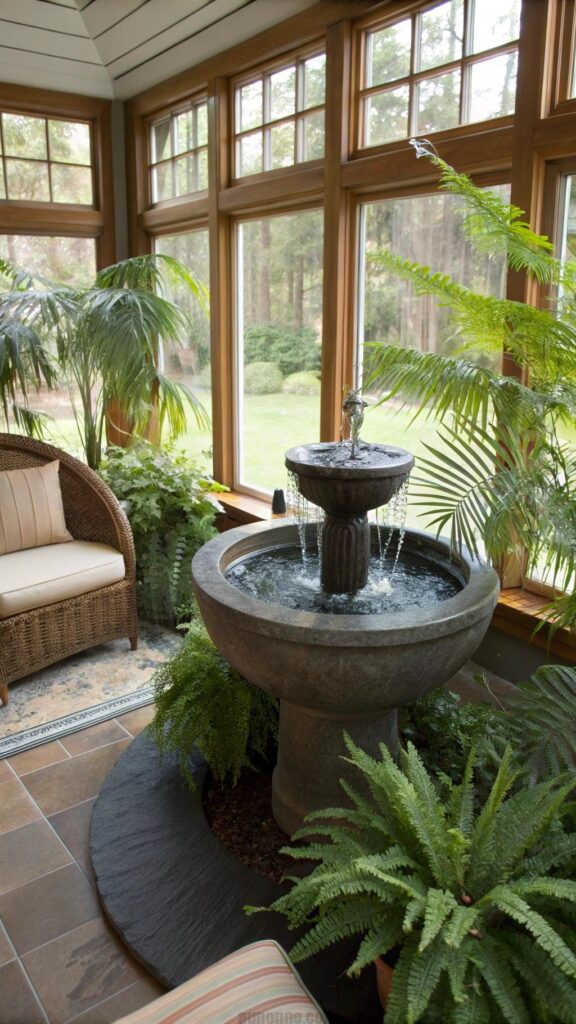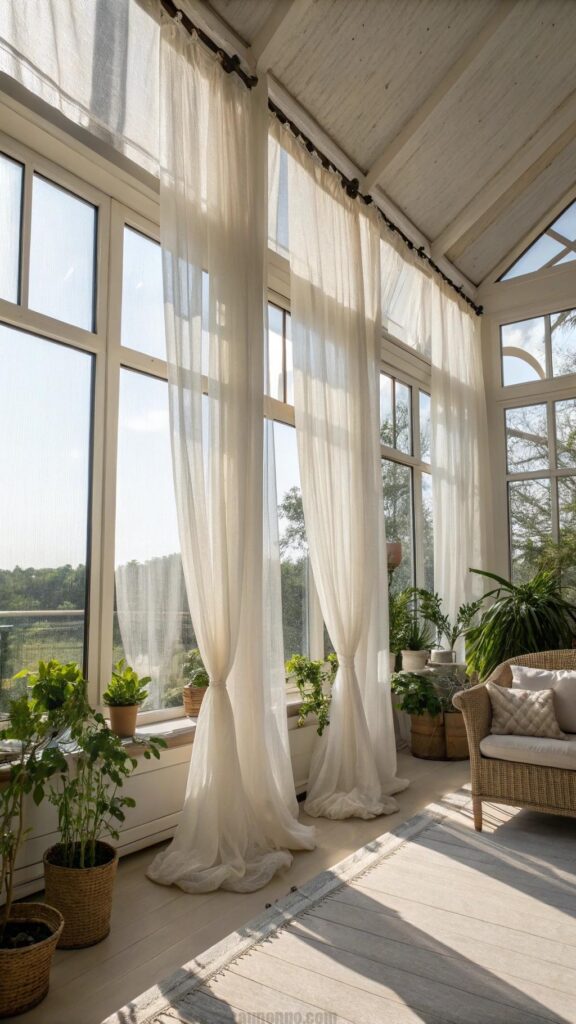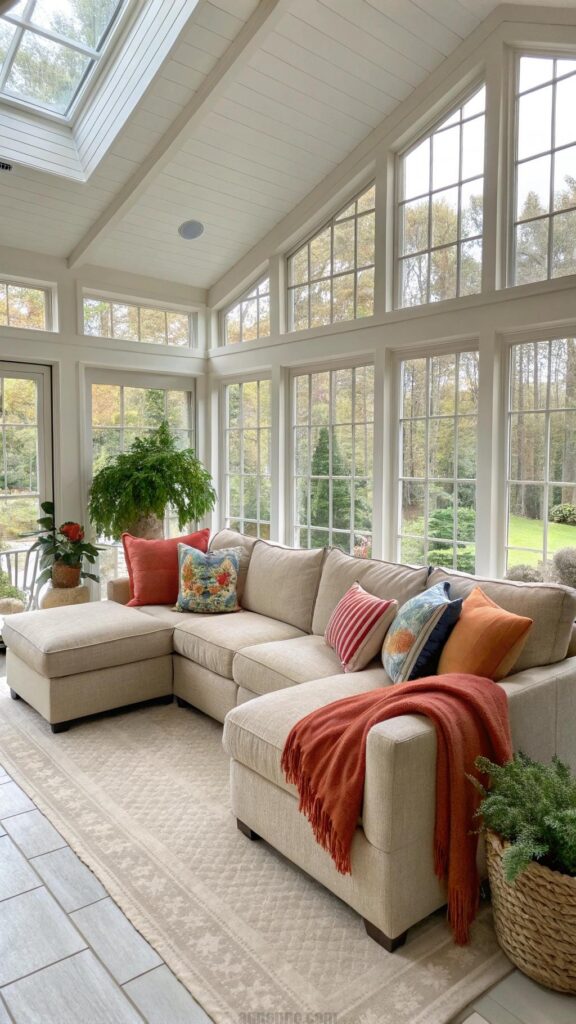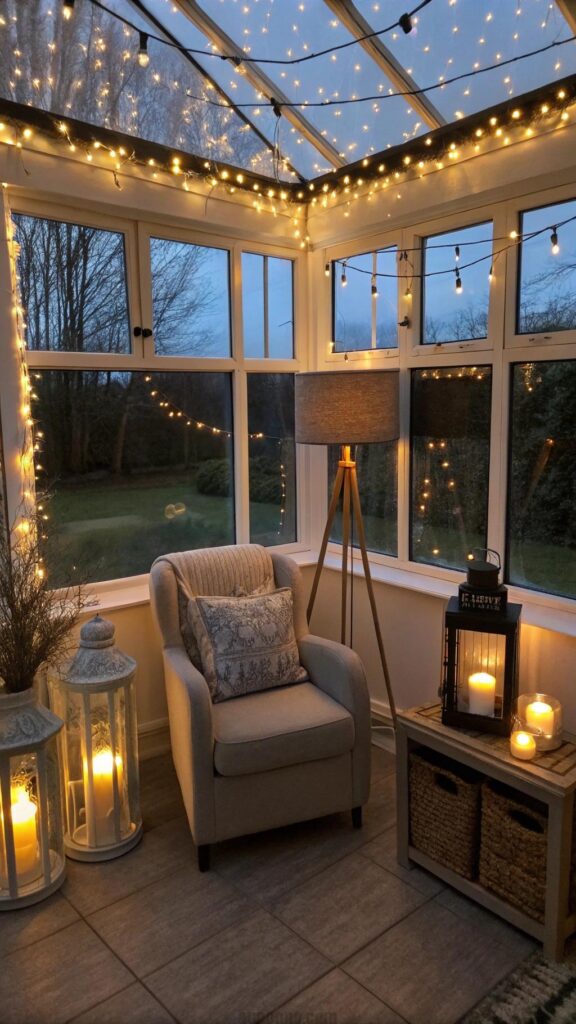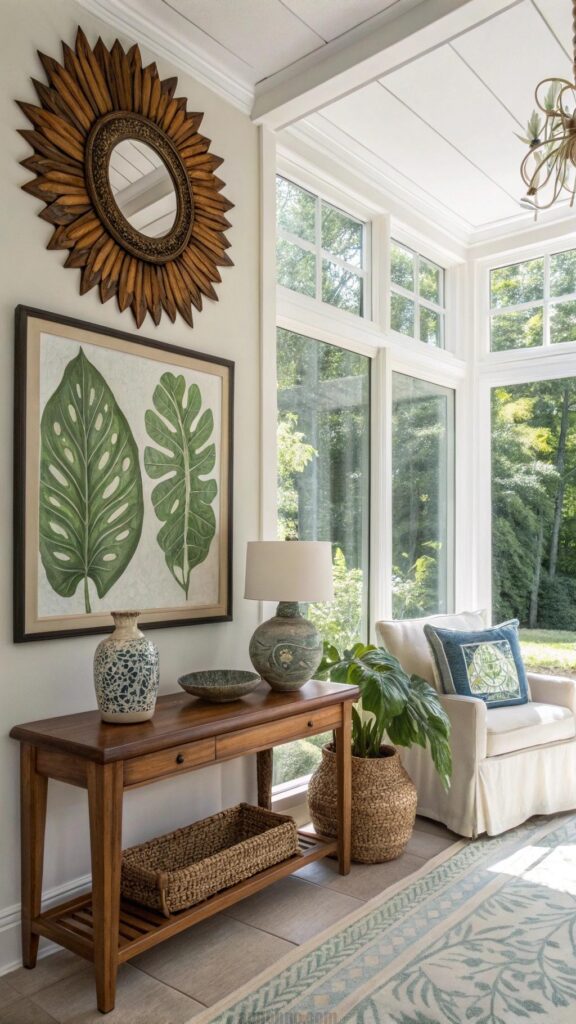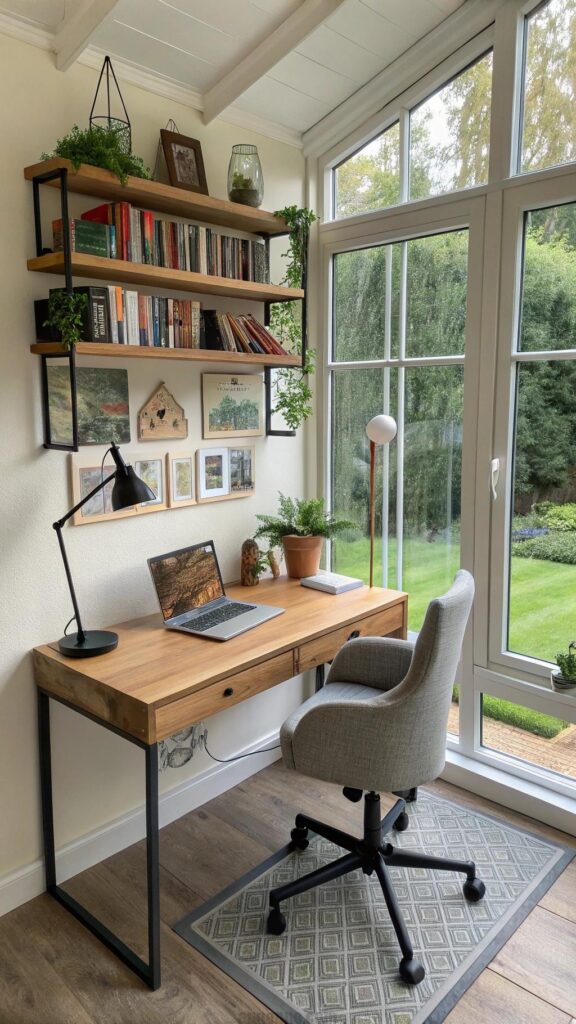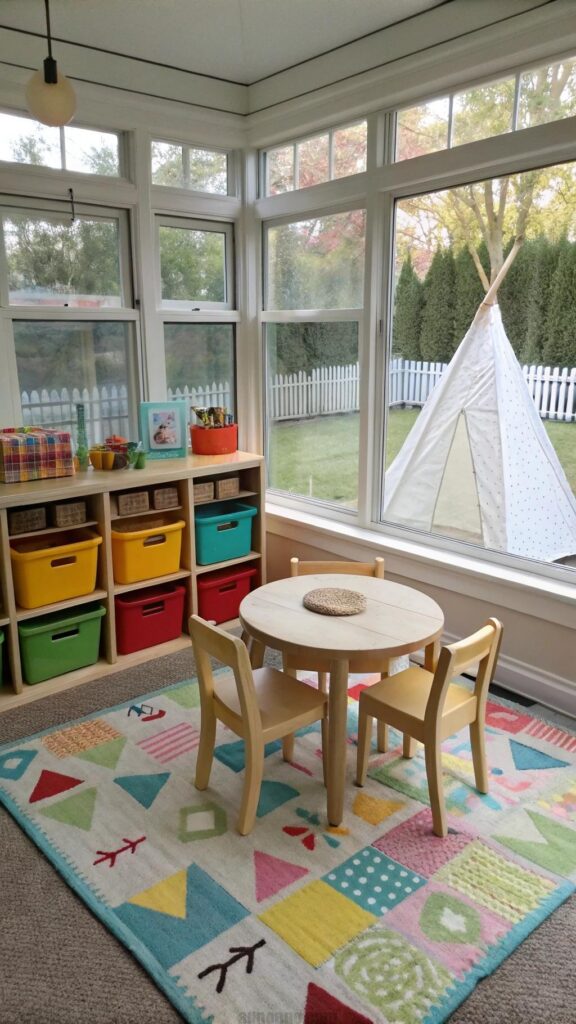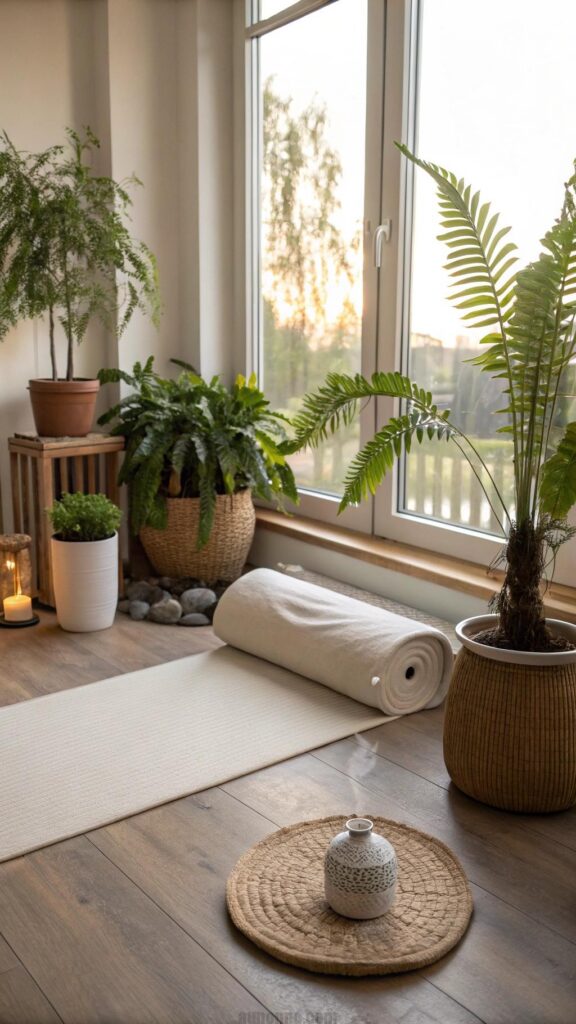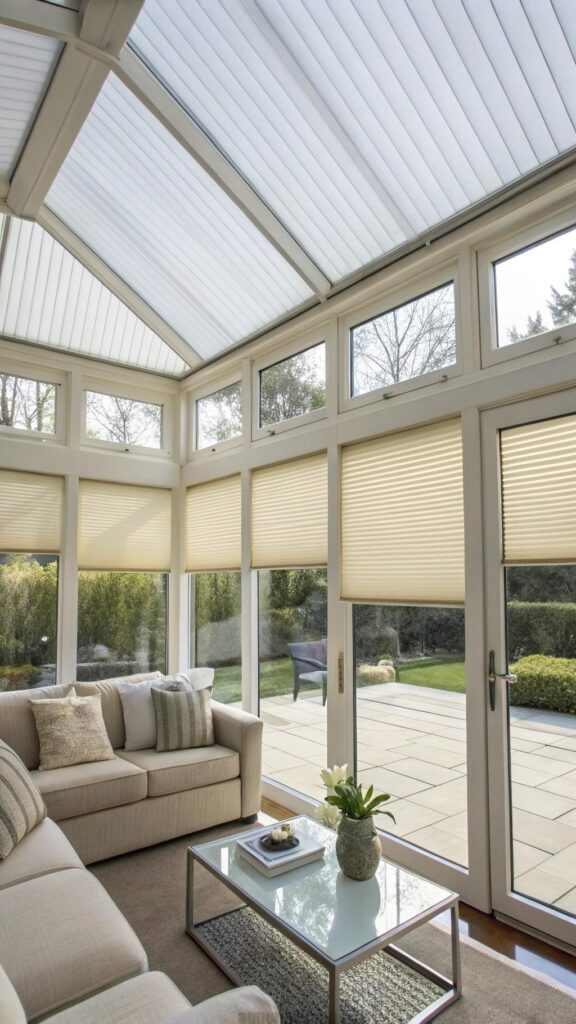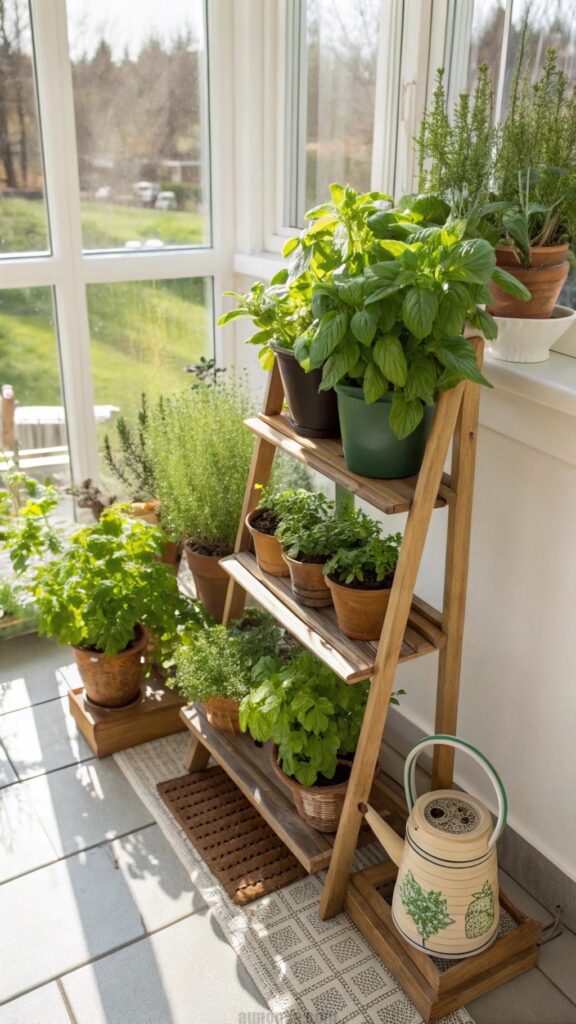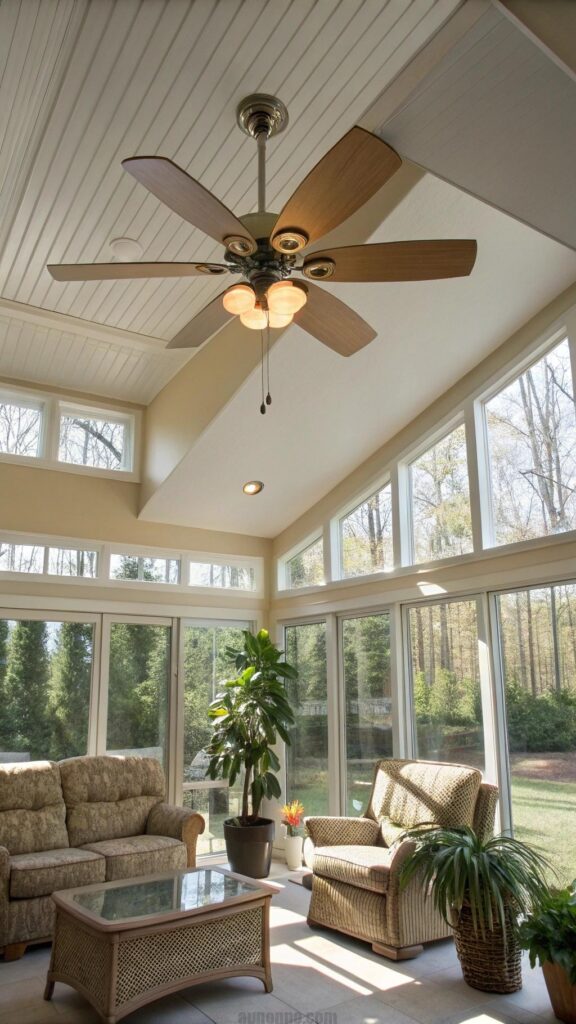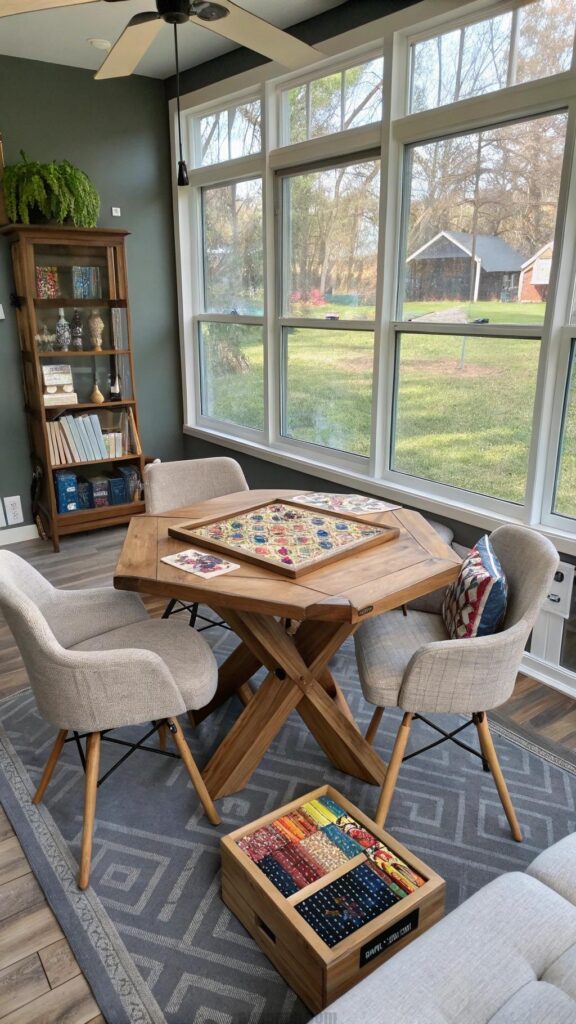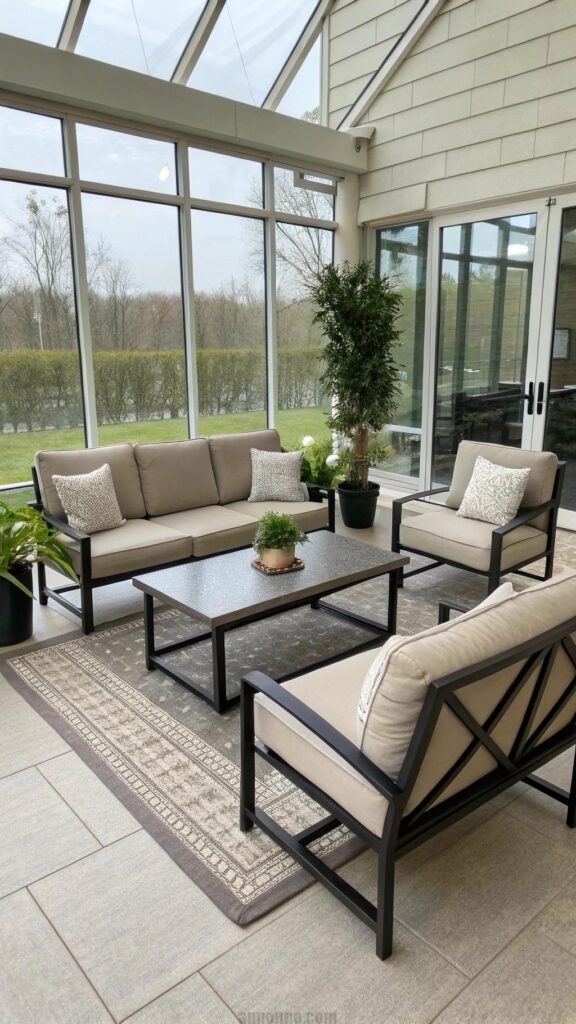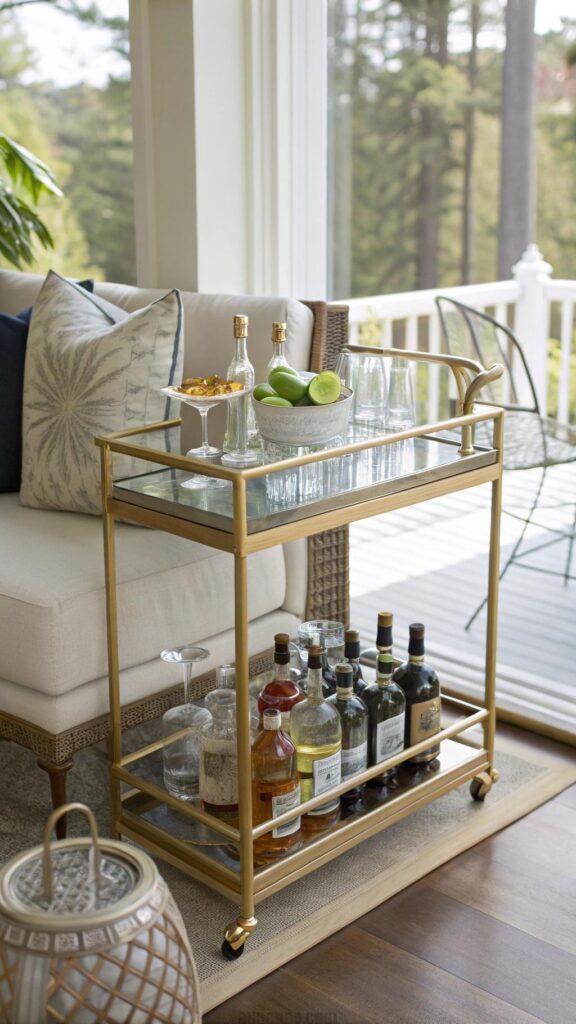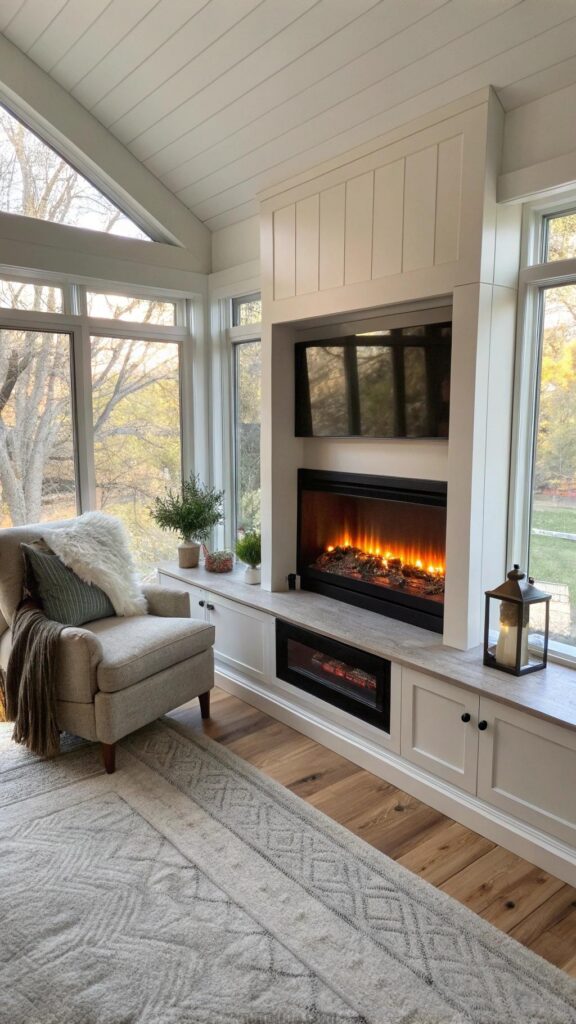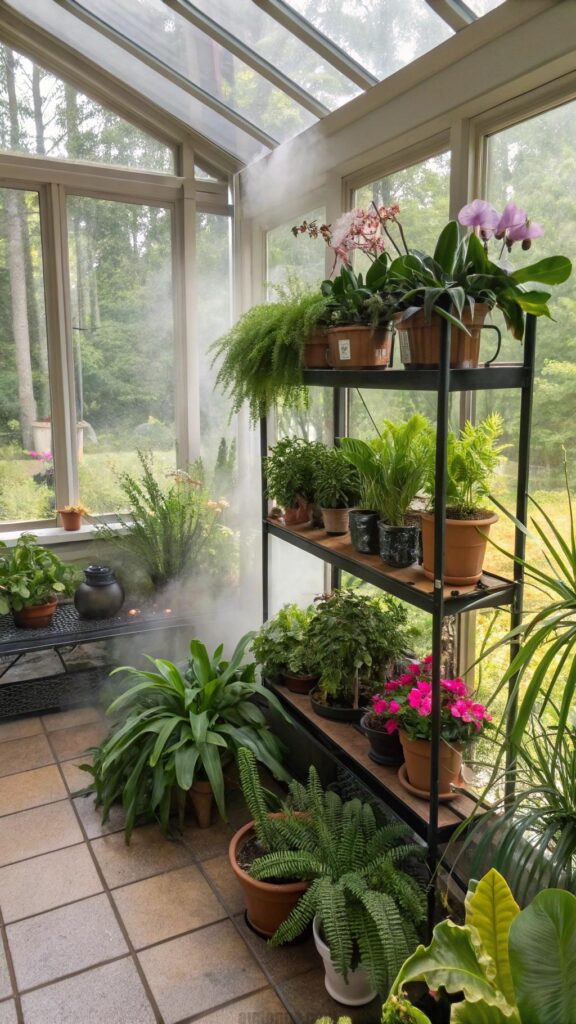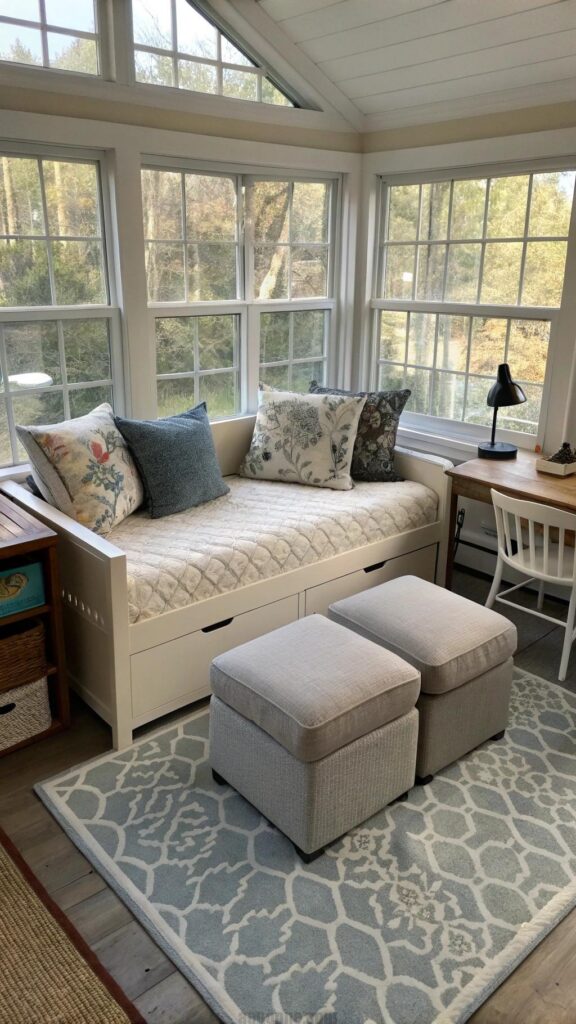Sunrooms offer a unique blend of indoor comfort and outdoor beauty. They provide a tranquil space where you can relax, entertain, and enjoy natural light throughout the year.
Decorating a sunroom requires careful consideration of its purpose and the amount of sunlight it receives.
These 25 sunrooms decorating ideas will help you transform your space into a beautiful and functional extension of your home.
Embrace Natural Elements
Bring the outdoors in by incorporating natural materials and textures. Think about using wicker or rattan furniture to create a light and airy feel. Wooden accents and stone elements can also add to the organic aesthetic.
Plants are essential for a sunroom, enhancing the connection to nature. Choose a variety of greenery, from tall potted trees to hanging baskets. These living elements purify the air and add vibrant color to the space.
Consider natural fiber rugs, such as jute or sisal, to ground your seating area. These materials are durable and add a touch of rustic charm. Soft linen or cotton throws can complete the cozy, natural look.
Create a Cozy Reading Nook
A sunroom is an ideal spot for a comfortable reading nook. Place a plush armchair or a chaise lounge in a corner bathed in sunlight. Add soft pillows and a warm throw blanket for ultimate comfort.
Install a small bookshelf or floating shelves nearby to keep your favorite books organized. A floor lamp with adjustable lighting will provide illumination for evening reading sessions. This dedicated space encourages relaxation and quiet contemplation.
Consider a small side table to hold your coffee or tea, along with a plant or a decorative item. The goal is to create an inviting sanctuary where you can escape into a good book. This personal retreat will become your favorite spot.
Design a Dining Area
Transform your sunroom into a charming dining space perfect for family meals or entertaining guests. A round or rectangular dining table can fit comfortably, depending on the room’s dimensions. Choose chairs that are comfortable and complement the sunroom’s bright aesthetic.
Consider a light-colored palette for your dining set to enhance the airy feel of the sunroom. Adding a small buffet or console table provides extra storage for dishes and serving essentials. This setup allows you to enjoy meals with a view of your garden or surroundings.
Overhead lighting, such as a delicate chandelier or pendant lights, can create an inviting ambiance for evening dining. Incorporate fresh flowers or a fruit bowl as a centerpiece to add natural beauty. This dining area will become a delightful spot for everyday use and special occasions.
Incorporate Water Features
Adding a small water feature can bring a sense of tranquility and a soothing sound to your sunroom. A tabletop fountain or a small freestanding water wall creates a calming atmosphere. The gentle sound of flowing water helps to reduce stress and enhance relaxation.
Water features also introduce an element of nature, complementing the sunroom’s connection to the outdoors. Choose a design that fits the overall aesthetic of your space, whether it is modern or more traditional. Ensure proper placement to avoid splashing and maintain humidity levels.
Consider adding some aquatic plants or smooth river stones to the base of your water feature for an even more natural look. The visual appeal of moving water adds dynamic interest to the room. This simple addition can significantly elevate the peaceful ambiance of your sunroom.
Use Light and Sheer Curtains
Light and sheer curtains are perfect for sunrooms, allowing natural light to filter through while providing a touch of privacy. They help to diffuse harsh sunlight, creating a softer, more inviting glow. Choose fabrics like linen, cotton, or voile for an airy feel.
These curtains also add a layer of texture and elegance without blocking the view of your outdoor surroundings. They can be easily pulled back to maximize sunlight or closed for a bit of shade. The right curtains enhance the room’s aesthetic appeal.
Opt for light colors such as white, cream, or pastels to maintain the bright and open feel of the sunroom. These colors reflect light, making the space appear larger and more luminous. Sheer curtains are a practical and beautiful choice for any sunroom.
Install Comfortable Seating
Comfortable seating is crucial for a sunroom, encouraging relaxation and prolonged enjoyment of the space. Choose sofas and armchairs with deep cushions and soft upholstery. Sectionals can be a great option for larger sunrooms, providing ample seating for family and guests.
Consider weather-resistant fabrics if your sunroom is exposed to significant temperature fluctuations or humidity. Outdoor-grade cushions can also be a practical choice, offering durability and easy cleaning. Arrange seating to maximize views and create conversational areas.
Add plenty of throw pillows and blankets to enhance comfort and add pops of color or texture. These elements make the space feel more inviting and lived-in. Your sunroom will become a favorite spot for lounging and unwinding.
Add Decorative Lighting
Beyond natural light, decorative lighting can significantly enhance the ambiance of your sunroom, especially during evenings. String lights or fairy lights can create a magical and whimsical atmosphere. Place them along the ceiling beams or around window frames for a soft glow.
Floor lamps and table lamps provide task lighting for reading or other activities. Choose fixtures that complement your sunroom’s style, whether it is modern, rustic, or traditional. Dimmers can be installed to control the intensity of the light, allowing for various moods.
Consider lanterns with LED candles for a safe and charming alternative to traditional candles. These add a warm, inviting touch without the fire hazard. Thoughtful lighting design extends the usability and enjoyment of your sunroom into the night.
Incorporate Art and Decor
Personalize your sunroom with art and decorative pieces that reflect your style. Choose artwork that complements the natural surroundings, such as botanical prints, landscapes, or abstract pieces with earthy tones. Avoid placing valuable art in direct sunlight to prevent fading.
Mirrors can be strategically placed to reflect light and make the sunroom feel even more spacious and bright. They also offer interesting visual elements and can reflect views of your garden. Consider a large statement mirror or a collection of smaller ones.
Add decorative objects like sculptures, vases, or unique pottery to tabletops and shelves. These small touches contribute to the room’s character and make it feel more lived-in. Curated decor elevates the overall design of your sunroom.
Choose Durable Flooring
Selecting the right flooring for your sunroom is essential, as it needs to withstand sunlight exposure and potential moisture. Tile, stone, or concrete are excellent choices due to their durability and resistance to fading. These materials also help to keep the room cool in warmer months.
Engineered wood or laminate flooring can also be considered, provided they are rated for high-sun exposure and humidity. Avoid solid hardwood unless it is specifically treated for sunroom conditions, as it can warp or fade. The right flooring provides a stable and attractive foundation for your decor.
Area rugs can add warmth and comfort to hard flooring surfaces. Choose rugs made from natural fibers or synthetic materials designed for outdoor use to ensure longevity. Durable flooring ensures your sunroom remains beautiful and functional for years to come.
Create a Home Office Space
A sunroom can serve as an inspiring and bright home office, offering a refreshing alternative to traditional workspaces. Position a desk near a window to take advantage of the natural light and views. Choose a comfortable chair that provides good ergonomic support for long hours of work.
Keep office supplies organized with stylish storage solutions like wall-mounted shelves or a small filing cabinet. Integrate plants and natural elements to create a calming and productive environment. This setup can boost creativity and reduce eye strain.
Ensure adequate lighting for evening work with a good desk lamp and ambient overhead lighting. Consider privacy blinds or shades if your sunroom is visible from outside. A sunroom office provides a pleasant and unique work setting.
Design a Play Area for Kids
A sunroom can be an excellent dedicated play area for children, offering a bright and open space for their activities. Lay down a soft, durable rug or interlocking foam mats to provide a comfortable and safe surface for play. Choose furniture that is child-sized and easy to clean.
Incorporate colorful storage bins or baskets to keep toys organized and easily accessible. A small table and chairs can be used for arts and crafts or puzzles. Natural light in the sunroom makes it an ideal environment for creative play and learning.
Consider adding a small tent or a teepee to create a cozy hideaway for imaginative adventures. Ensure that all windows are secure and that any potential hazards are removed. This dedicated play space allows children to enjoy the outdoors safely, regardless of the weather.
Create a Meditation or Yoga Space
Transform your sunroom into a peaceful sanctuary for meditation or yoga. The abundance of natural light and connection to nature makes it an ideal spot for mindfulness practices. Lay down a soft yoga mat or a comfortable cushion in the center of the room.
Keep the decor minimal and serene, focusing on calming colors and natural textures. Add elements like indoor plants, a small water feature, or soothing aromatherapy diffusers to enhance the tranquil atmosphere. This dedicated space promotes relaxation and inner peace.
Consider soft, indirect lighting for evening sessions, such as salt lamps or dimmable floor lamps. Play gentle instrumental music or nature sounds to deepen your practice. Your sunroom can become a personal retreat for spiritual well-being.
Install Blinds or Shades for Light Control
While natural light is a sunroom’s main appeal, too much can be overwhelming, especially during peak sun hours. Installing blinds, shades, or even smart glass can provide essential light control. These options allow you to adjust the amount of sunlight entering the room, preventing glare and overheating.
Consider cellular shades for their insulating properties, which can help regulate temperature year-round. Roman shades offer a softer, more decorative look, while roller shades provide a sleek and minimalist solution. Choose materials that are resistant to fading and warping from sun exposure.
Motorized blinds or shades offer convenience, allowing you to adjust them with the touch of a button or even integrate them into a smart home system. Proper light control ensures your sunroom remains comfortable and functional throughout the day. This investment enhances both comfort and energy efficiency.
Create a Small Herb Garden
Utilize your sunroom’s abundant light to cultivate a small indoor herb garden. Place potted herbs like basil, mint, rosemary, and thyme on a sunny windowsill or a tiered plant stand. This provides fresh ingredients for your cooking and adds a delightful aroma to the space.
Ensure your herbs receive adequate drainage and are watered regularly. Consider using attractive ceramic or terracotta pots to enhance the visual appeal of your garden. A small watering can and gardening tools can be stored nearby for convenience.
An indoor herb garden connects you with nature and offers a rewarding hobby. It transforms your sunroom into a functional and fragrant space. Enjoy the fresh flavors and vibrant greenery all year long.
Add a Pop of Color
While natural light and neutral tones are common in sunrooms, adding strategic pops of color can infuse personality and vibrancy. Use colorful throw pillows, blankets, or accent chairs to introduce bold hues. These small additions can dramatically change the room’s mood.
Consider vibrant potted plants with colorful blooms, such as orchids or bromeliads, to add natural splashes of color. Artwork with bright palettes can also serve as focal points, drawing the eye and adding visual interest. The key is to use color sparingly to avoid overwhelming the space.
Brightly colored rugs or decorative accessories like vases and sculptures can also contribute to a lively atmosphere. These elements create a cheerful and inviting environment. A touch of color makes your sunroom feel more dynamic and personal.
Incorporate a Swing or Hanging Chair
For a touch of whimsy and ultimate relaxation, consider adding a swing or a hanging chair to your sunroom. These unique seating options provide a playful element and a comfortable spot to unwind. They create a focal point and invite you to linger.
Ensure that the ceiling support is adequate to safely hold the weight of the chair and its occupant. Choose a style that complements your sunroom’s decor, whether it is a bohemian macrame swing or a sleek modern bubble chair. Add soft cushions and a throw for extra comfort.
A hanging chair offers a gentle swaying motion that can be incredibly soothing. It is a perfect spot for reading, daydreaming, or simply enjoying the view. This addition elevates the fun and relaxation factor of your sunroom.
Create a Pet-Friendly Zone
If you have furry friends, dedicate a corner of your sunroom to their comfort and enjoyment. Place a cozy pet bed or a comfortable cushion in a sunny spot where they can nap. Ensure there is easy access to water bowls and toys.
Consider durable and easy-to-clean flooring and furniture in this area to withstand pet activity. Keep pet supplies neatly organized in baskets or decorative containers. This designated space allows your pets to enjoy the sunroom safely and comfortably.
Add a scratching post for cats or a chew toy basket for dogs to keep them entertained. Ensure any plants in the sunroom are non-toxic to pets. A pet-friendly sunroom benefits both you and your beloved companions.
Utilize Vertical Space with Shelving
Maximize storage and display opportunities in your sunroom by utilizing vertical space with shelving units. Open shelves can showcase decorative items, books, or small potted plants without making the room feel cluttered. Wall-mounted shelves are particularly useful for smaller sunrooms.
Consider a tall, narrow bookshelf or a ladder shelf to add visual interest and functionality. These units provide ample space for organizing and displaying your favorite collections. They keep the floor clear, contributing to an open and airy feel.
Arrange items aesthetically, mixing different heights and textures for a dynamic display. Shelving also offers a practical solution for keeping the sunroom tidy and organized. This approach makes the most of every inch of your sunroom.
Install a Ceiling Fan
A ceiling fan is a practical and stylish addition to any sunroom, especially in warmer climates. It helps to circulate air, keeping the room cool and comfortable without the need for constant air conditioning. Choose a fan that complements the overall design aesthetic of your sunroom.
Look for models with integrated lighting to provide both air circulation and illumination. A remote control feature adds convenience, allowing you to adjust fan speed and light settings from your seat. Proper air circulation prevents the sunroom from becoming stuffy.
Consider a damp-rated fan if your sunroom is exposed to high humidity or occasional moisture. A well-chosen ceiling fan enhances comfort and extends the usability of your sunroom throughout the year. It is a functional element that contributes to the room’s overall appeal.
Create a Game or Hobby Area
Transform your sunroom into a dedicated space for games, puzzles, or your favorite hobbies. A sturdy table and comfortable chairs can accommodate board games, card games, or crafting activities. This area provides a bright and inspiring environment for leisure.
Consider storage solutions for game boards, puzzles, and hobby supplies to keep the area tidy. A portable cart or a small cabinet can hold everything neatly. The natural light is ideal for detailed work, reducing eye strain.
Add a comfortable rug to define the space and provide a soft surface underfoot. This dedicated hobby zone encourages relaxation and engagement in enjoyable activities. Your sunroom can become a hub for fun and creativity.
Use Outdoor-Grade Furniture
Even if your sunroom is fully enclosed, using outdoor-grade furniture can be a smart choice. These pieces are designed to withstand sunlight, humidity, and temperature fluctuations, ensuring longevity. Materials like aluminum, synthetic wicker, or treated wood are excellent options.
Outdoor fabrics are fade-resistant and easy to clean, making maintenance a breeze. They also tend to be more durable, standing up to heavy use. This type of furniture ensures your sunroom remains beautiful and functional for years.
Many outdoor furniture sets now come in stylish designs that blend seamlessly with indoor decor. This allows for a cohesive look while providing practical benefits. Investing in outdoor-grade furniture is a wise decision for any sunroom.
Incorporate a Bar Cart
Elevate your sunroom’s entertaining potential by adding a stylish bar cart. This mobile station can hold beverages, glassware, and cocktail essentials, making it easy to serve guests. Choose a cart that complements your sunroom’s decor, whether it is vintage, modern, or rustic.
A bar cart adds a touch of sophistication and convenience to your sunroom. It can be easily moved to different areas as needed, making it versatile for various gatherings. Stock it with your favorite drinks and some fresh garnishes for an inviting display.
Consider adding a small ice bucket and some decorative coasters to complete the setup. A well-stocked bar cart encourages impromptu gatherings and adds a festive touch to your sunroom. It is a functional and fashionable addition.
Add a Fireplace or Heater
Extend the usability of your sunroom into cooler months by adding a fireplace or a portable heater. A small electric fireplace can provide warmth and a cozy ambiance without the need for ventilation. This creates a comfortable environment for year-round enjoyment.
Consider a wall-mounted electric heater or an infrared heater for efficient and targeted warmth. These options are easy to install and operate, making them practical for occasional use. A fireplace also adds a visual focal point to the room.
Arrange comfortable seating around the heat source to create a warm and inviting gathering spot. This allows you to enjoy your sunroom even when temperatures drop. A heating element transforms your sunroom into a versatile space for all seasons.
Incorporate a Greenhouse Area
For plant enthusiasts, a sunroom offers the perfect environment to create a mini-greenhouse area. Install shelving or a dedicated plant bench to house a variety of potted plants, including those that require specific light conditions. This allows you to cultivate a diverse collection.
Consider adding a small humidifier or a misting system to maintain optimal humidity levels for your plants. Proper ventilation is also important to prevent mold and mildew. This dedicated space supports the growth of healthy and vibrant plants.
Group plants with similar needs together for easier care and maintenance. A greenhouse area transforms your sunroom into a lush, living sanctuary. It is a rewarding way to connect with nature and expand your gardening passion.
Design a Multi-Functional Space
If your sunroom is not large enough for a single dedicated purpose, consider designing it as a multi-functional space. Use furniture that can serve multiple roles, such as a daybed that functions as both seating and an extra sleeping area. Ottomans with storage can hide clutter and provide additional seating.
Modular furniture allows for flexible arrangements, adapting to different activities like reading, entertaining, or working. Define different zones within the sunroom using area rugs or strategic furniture placement. This approach maximizes the utility of your sunroom.
Ensure that each zone has appropriate lighting and access to power outlets for its intended use. A multi-functional sunroom becomes a versatile extension of your home, catering to various needs throughout the day. It is a practical solution for optimizing space.
Frequently Asked Questions about Sunroom Decorating Ideas
What is the best type of flooring for a sunroom?
The best flooring for a sunroom is durable and resistant to sunlight and moisture. Options like tile, stone, or concrete are excellent choices. Engineered wood or laminate can also work if they are rated for high sun exposure.
These materials help keep the room cool and prevent fading or warping. Natural fiber rugs can add warmth and comfort to hard surfaces. Always consider the specific conditions of your sunroom when making a choice.
How can I keep my sunroom from getting too hot?
To prevent your sunroom from overheating, consider installing blinds, shades, or smart glass for light control. Cellular shades offer good insulation properties. Proper ventilation, such as ceiling fans or operable windows, also helps.
Using light-colored materials for furniture and decor can reflect heat. Strategic placement of plants can also provide some natural shading. These measures ensure a comfortable temperature even on sunny days.
What kind of plants thrive in a sunroom?
Many plants thrive in the bright, consistent light of a sunroom. Tropical plants like palms, ferns, and orchids often do very well. Succulents and cacti also enjoy the abundant sunlight.
Herbs such as basil, mint, and rosemary can flourish in a sunroom, providing fresh ingredients. Always research the specific light and humidity needs of each plant. Ensure proper drainage and regular watering for healthy growth.
How do I choose furniture for a sunroom?
When choosing sunroom furniture, prioritize comfort and durability. Materials like wicker, rattan, or outdoor-grade aluminum are excellent choices. Look for weather-resistant fabrics that can withstand sunlight and humidity.
Consider the size and layout of your sunroom to ensure furniture fits well and allows for easy movement. Sectionals or multi-functional pieces can maximize seating in smaller spaces. Add soft cushions and throws for enhanced comfort.
Can a sunroom be used year-round?
Yes, a sunroom can be used year-round with proper planning and design. Insulation, double-paned windows, and effective heating and cooling systems are key. Portable heaters or ceiling fans can help regulate temperature.
Blinds or shades provide light control and insulation against extreme temperatures. By addressing temperature control and comfort, your sunroom can be a versatile space in all seasons. This ensures maximum enjoyment of the space.
How can I add privacy to my sunroom?
Adding privacy to your sunroom can be achieved through various methods. Sheer curtains allow light in while offering a degree of privacy. Blinds, shades, or shutters provide more complete coverage when needed.
Strategic placement of tall plants or privacy screens can also create a natural barrier. Frosted or tinted window films offer a permanent solution for privacy. These options help create a secluded and comfortable environment.
What are some budget-friendly sunroom decorating ideas?
Budget-friendly sunroom decorating ideas include using existing furniture and updating it with new cushions or slipcovers. Incorporate affordable natural elements like potted plants and natural fiber rugs. DIY projects can also save money.
Look for second-hand furniture or decor items that can be repurposed. Use string lights for inexpensive ambient lighting. Simple changes can make a big impact without a large investment.
How do I clean and maintain a sunroom?
Regular cleaning and maintenance are essential for a sunroom. Dust and wipe down surfaces regularly to prevent buildup. Clean windows frequently to maintain clarity and maximize light.
Vacuum or sweep flooring as needed, and spot clean any spills immediately. Check plants for pests and water them appropriately. Addressing maintenance proactively keeps your sunroom looking its best.
Can I install a TV in my sunroom?
Yes, you can install a TV in your sunroom but consider placement carefully. Avoid direct sunlight on the screen to prevent glare and overheating. A wall-mounted TV can save space and offer better viewing angles.
Consider a TV designed for outdoor or semi-outdoor use, as these are more durable. Ensure proper wiring and protection from moisture. This allows for entertainment while enjoying the natural surroundings.
What is the ideal color palette for a sunroom?
The ideal color palette for a sunroom often includes light, airy, and natural tones. Whites, creams, light grays, and soft pastels enhance the bright and open feel. These colors reflect natural light, making the space feel larger.
Conclusion
Transforming your sunroom into a functional and beautiful space is an exciting endeavor. These 25 sunrooms decorating ideas offer a wide range of possibilities, from creating a cozy reading nook to designing a vibrant home office.
